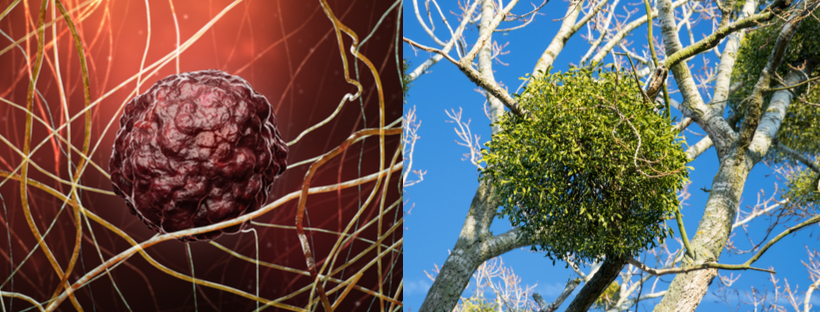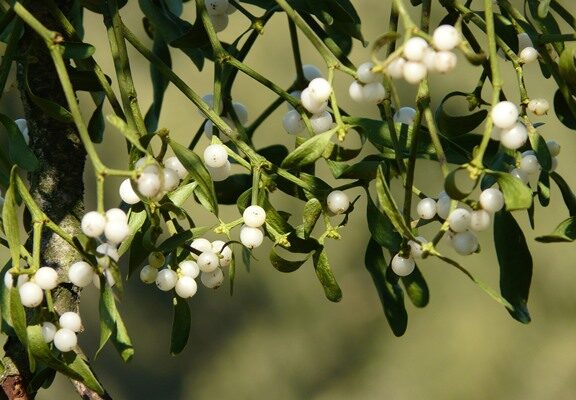MISTLETOE THERAPY
Mistletoe (Viscum Album) has been known since ancient times to be not only a magic plant, but also a healing, holy plant.
It is one of the most widely studied complementary and alternative medicine therapies for Cancer. In European countries extracts made from the mistletoe plant are among the most prescribed therapies for cancer patients.
It was not until the 1920s that Austrian philosopher-scientist Rudolf Steiner, PhD applied the usage of mistletoe as a cancer therapy after noticing a parallel between the parasitic nature of the plant and the parasitic invasion of the body by cancer.
“Real medicine can only exist when it penetrates into a knowledge which embraces the human being in respect to body, soul and spirit” – Rudolf Steiner
It is a semi-parasitic plant, because it works in symbiosis with the host trees, like apple, oak, maple, elm, pine and birch but doesn’t impact these trees in any negative way.

History
For centuries, Mistletoe has been considered a plant that increases life and fertility. It was used to treat epilepsy, hypertension, atherosclerosis, asthma and menopausal problems. According to custom, people can share a true love’s kiss beneath the mistletoe and it is also believed that such a kiss can mend a broken heart.


- Autonomy: The Mistletoe emancipates itself from the normal biological rhythms in nature to which other plants are subjected, and thereby asserts its autonomy, just like a malignant tumor.
- Parasitic nature: It is a half parasitic plant growing on host trees but in many aspects, it is independent of the host. Cancerous cells are like a parasite, deriving nutrition from the human host but independent of the organism.
- Indefinite growth: Mistletoe has an inherent tendency to indefinite growth and proliferation in its leaves, flowers and berries. It has a continuous life cycle which has correspondence to continuous unhampered, unlimited growth of cancer. The stalks and leaves of the mistletoe grow on all sides and in all directions just like cancer grows in all directions. The upper and lower surfaces of a pair of leaves of the mistletoe are undifferentiated like an undifferentiated carcinoma.
- Death: The Mistletoe dies only after the host tree dies or when the host tree no longer supplies adequate nourishment.
- Potassium: The Mistletoe is rich in potassium, more than in the host tree; cancerous tissue is also rich in potassium.

- Immunomodulatory effect: Supports and strengthens the immune system
- Cytotoxicity: Direct action on the cancer cells causing cell death (Apoptosis).
- Reduction of side effects (Chemotherapy & Radiation): DNA stabilizing effect in peripheral blood mononuclear cells resulting in significant protection from immunosuppressive effects of chemotherapy.
- Anti-angiogenesis: Inhibits the growth of new vasculature of the tumour.
- Salutogenesis: Focuses on supporting human health and well-being.
- Treatment of all malignant and benign tumours either as a primary therapy to provide immune stimulation or as an adjuvant therapy along with chemotherapy and radio-therapy.
- Preventively, in precancerous conditions.
- Treatment of inoperable tumours, recurrences and metastases; in terminal cases as it has a palliative action.
Benefits of Mistletoe Therapy

In clinical studies in the course of supportive / adjunct treatment in addition to conventional oncologic therapies Mistletoe showed:
1. Improvement in Quality of life
Increase in appetite, weight, improved stamina / vitality to carry out normal functions, normalisation of sleep.
Improvement of the mood, reduced depressive states.
2. Inhibition of tumour growth with no damage to healthy tissues and reduction in the pain due to tumours.
3.Improvement of Immunological parameters:
Increase in red blood cells, haemoglobin, white blood cells and platelets.
4. Better tolerance to Chemotherapy, Radiation, Target therapies:
:Most side effects and adverse drug reactions like nausea, vomiting, diarrhoea, pain and weakness are greatly reduced.
5. Prevention of Relapses and Metastases.
6. Stimulation of bone marrow function.
7. Overall improvement in Survival of cancer patients.
8. Better Palliative care:
Reduced cancer fatigue, relief from cancer related pains, reduction in infections, and generally, feeling better.

 Hi, I am one of an old patient of Dr. Zubin Marolia under his treatment for more than a decade now. He has treated me for any and every problem of my wellbeing. The results stands healthily satisfying for me each time.
Hi, I am one of an old patient of Dr. Zubin Marolia under his treatment for more than a decade now. He has treated me for any and every problem of my wellbeing. The results stands healthily satisfying for me each time. My name is Rashmi Lotlikar and I went to Dr. Zubin Marolia for a skin infection called Molluscum Contagiosum.
My name is Rashmi Lotlikar and I went to Dr. Zubin Marolia for a skin infection called Molluscum Contagiosum. I am a patient of cancer since 2016. After surgery and radiation I was put on Hormone therapy wherein I have to take a pill every day for five years. I was facing a lot of nausea all day and lack of appetite and anxiety problems with the result I had lost 10 kgs. The doctors gave a lot of allopathy medicines to help me but nothing really worked. I was really desperate to find a solution and that iswhen I contacted Dr Zubin Marolia and asked him if homeopathy could help me in this respect.
I am a patient of cancer since 2016. After surgery and radiation I was put on Hormone therapy wherein I have to take a pill every day for five years. I was facing a lot of nausea all day and lack of appetite and anxiety problems with the result I had lost 10 kgs. The doctors gave a lot of allopathy medicines to help me but nothing really worked. I was really desperate to find a solution and that iswhen I contacted Dr Zubin Marolia and asked him if homeopathy could help me in this respect.  Mrs V S 83 years.
Mrs V S 83 years. I was diagnosed with breast cancer in November 2017. I went through the complete treatment cycle of surgery, chemo therapy and radiation therapy till June 2018. After I fully recovered from the cancer, my sister in law, who also is a homeopath, suggested me to meet Dr. Zubin sir for seeking a homeopathic approach to post cancer life.
I was diagnosed with breast cancer in November 2017. I went through the complete treatment cycle of surgery, chemo therapy and radiation therapy till June 2018. After I fully recovered from the cancer, my sister in law, who also is a homeopath, suggested me to meet Dr. Zubin sir for seeking a homeopathic approach to post cancer life.  Hello Doctor Zubin
Hello Doctor Zubin  I had Warts on my neck. I went to 2-3 dermatologist, they all told me there is no permanent solution to it.
I had Warts on my neck. I went to 2-3 dermatologist, they all told me there is no permanent solution to it. Dr. Zubin Marolia’s treatment is a real blessing. My teenaged son hadproblems of allergies, asthma, allergic rhinitis from childhood.
Dr. Zubin Marolia’s treatment is a real blessing. My teenaged son hadproblems of allergies, asthma, allergic rhinitis from childhood. Just speaking about my family’s experiences with homeopathy treatment given by our Dr. Zubin Marolia.
Just speaking about my family’s experiences with homeopathy treatment given by our Dr. Zubin Marolia.  I met Dr. Marolia, more fondly called Mamu, roughly two decades ago. My daughter’s pediatrician had his office right opposite, and we used to run into him regularly. He was always extremely friendly, and we all got along well.
I met Dr. Marolia, more fondly called Mamu, roughly two decades ago. My daughter’s pediatrician had his office right opposite, and we used to run into him regularly. He was always extremely friendly, and we all got along well. Hello, My mother Neela Nevrekar aged 69 was diagnosed with breast cancer in July 2017.
Hello, My mother Neela Nevrekar aged 69 was diagnosed with breast cancer in July 2017. The night I received the devastating diagnosis of Stage 3 Ovarian Cancer, a couple of months after my 43rd birthday, I was in an ICU, just about gaining consciousness from a debulking surgery that lasted about nine hours. It was surreal. The implications of the diagnosis did not sink in. I just realised I had a long struggle ahead of me.
The night I received the devastating diagnosis of Stage 3 Ovarian Cancer, a couple of months after my 43rd birthday, I was in an ICU, just about gaining consciousness from a debulking surgery that lasted about nine hours. It was surreal. The implications of the diagnosis did not sink in. I just realised I had a long struggle ahead of me. Hi everyone! I am Pushpa Gurnani, aged 65 years. I stay in India – Andheri West. I am married having 2 daughters one 42 yrs and the other one 37 yrs. I am a working woman.
Hi everyone! I am Pushpa Gurnani, aged 65 years. I stay in India – Andheri West. I am married having 2 daughters one 42 yrs and the other one 37 yrs. I am a working woman.  I’ll never forget my amazement at the first time Dr. Marolia had administered a medication to me for a serious injury, eleven years ago. I didn’t even have time to share my symptoms with him. While talking on the phone he said, “Naushad, I know your personality-psyche so therefore take the following remedy…”
I’ll never forget my amazement at the first time Dr. Marolia had administered a medication to me for a serious injury, eleven years ago. I didn’t even have time to share my symptoms with him. While talking on the phone he said, “Naushad, I know your personality-psyche so therefore take the following remedy…” Dr. Zubin Marolia is an excellent human being and a very kind hearted person. He is also an outstanding Homeopathic Doctor believing in integrative medicine. The reason for this sequence is that I personally believe that a good doctor has to be a kind human being to start with.
Dr. Zubin Marolia is an excellent human being and a very kind hearted person. He is also an outstanding Homeopathic Doctor believing in integrative medicine. The reason for this sequence is that I personally believe that a good doctor has to be a kind human being to start with. I have had the fortune of having been associated with Dr. Zubin P. Marolia as his patient, due to recurrent episodes of Sorethroat (Pharyngitis), coupled with headaches emanating from suspected Sinusitis, in respect of which as a last resort I took to Homeopathy. I also suffered an episode of “Herpes Zoster” at the age of 42 years in the month of September 2006.
I have had the fortune of having been associated with Dr. Zubin P. Marolia as his patient, due to recurrent episodes of Sorethroat (Pharyngitis), coupled with headaches emanating from suspected Sinusitis, in respect of which as a last resort I took to Homeopathy. I also suffered an episode of “Herpes Zoster” at the age of 42 years in the month of September 2006.